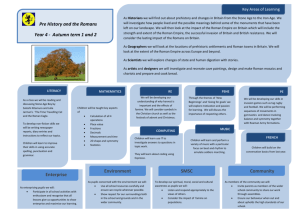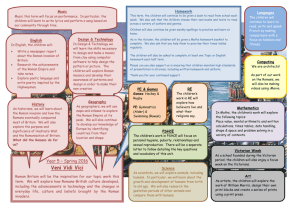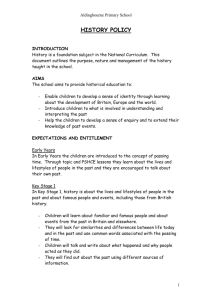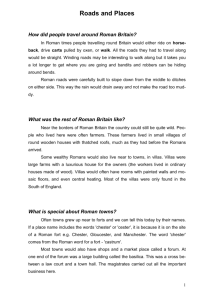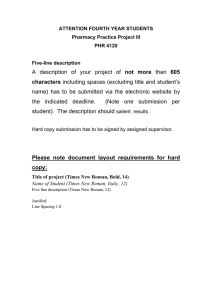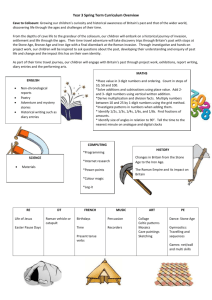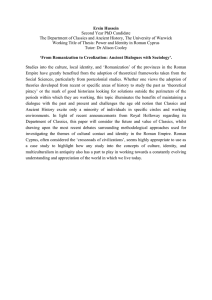Unit F387 - Classical civilisation - Roman Britain - Scheme of work and lesson plan booklet (DOC, 193KB)
advertisement
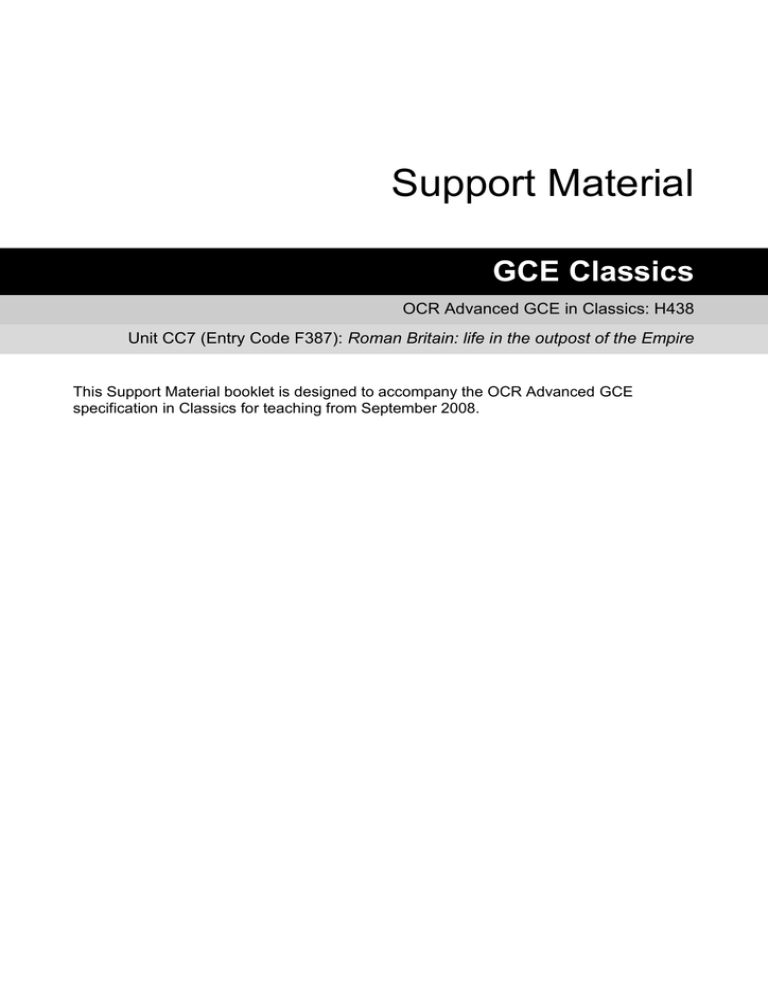
Support Material GCE Classics OCR Advanced GCE in Classics: H438 Unit CC7 (Entry Code F387): Roman Britain: life in the outpost of the Empire This Support Material booklet is designed to accompany the OCR Advanced GCE specification in Classics for teaching from September 2008. Contents Contents 2 Introduction 3 Classical Civilisation H441: Roman Britain: Life in the outpost of the Empire 5 Sample Lesson Plan: Classical Civilisation H441: Roman Britain: Life in the Outpost of the Empire F387 10 Other forms of Support 2 of 14 12 GCE Classics Introduction Background A new structure of assessment for A Level has been introduced, for first teaching from September 2008. Some of the changes include: The introduction of stretch and challenge (including the new A* grade at A2) – to ensure that every young person has the opportunity to reach their full potential The reduction or removal of coursework components for many qualifications – to lessen the volume of marking for teachers A reduction in the number of units for many qualifications – to lessen the amount of assessment for learners Amendments to the content of specifications – to ensure that content is up-to-date and relevant. OCR has produced an overview document, which summarises the changes to Classics. This can be found at www.ocr.org.uk, along with the new specification. In order to help you plan effectively for the implementation of the new specification we have produced this Scheme of Work and Sample Lesson Plan for Classics. These Support Materials are designed for guidance only and play a secondary role to the Specification. Our Ethos All our Support Materials were produced ‘by teachers for teachers’ in order to capture real life current teaching practices and they are based around OCR’s revised specifications. The aim is for the support materials to inspire teachers and facilitate different ideas and teaching practices. Each Scheme of Work and set of sample Lesson Plans is provided in: PDF format – for immediate use Word format – so that you can use it as a foundation to build upon and amend the content to suit your teaching style and students’ needs. The Scheme of Work and sample Lesson plans provide examples of how to teach this unit and the teaching hours are suggestions only. Some or all of it may be applicable to your teaching. The Specification is the document on which assessment is based and specifies what content and skills need to be covered in delivering the course. At all times, therefore, this Support Material booklet should be read in conjunction with the Specification. If clarification on a particular point is sought then that clarification should be found in the Specification itself. GCE Classics 3 of 14 A Guided Tour through the Scheme of Work = Innovative Teaching Idea All the teaching ideas contained in the SOW are innovative, but the icon is used to highlight exceptionally innovative ideas. = Stretch & Challenge Activity This icon is added at the end of text when there is an explicit opportunity to offer Stretch and Challenge. = ICT Opportunity This icon is used to illustrate when an activity could be taught using ICT facilities. 4 of 14 GCE Classics Classical Civilisation H441: Roman Britain: Life in the outpost of the Empire Suggested teaching time 10 hours Topic outline Topic Urbanisation and the towns of Roman Britain Suggested teaching and homework activities Suggested resources Points to note Bennet J. Towns in Roman Britain, 1980, Shire, is basic but a good introduction. All the suggested resources are suitable for student use. Salway P. (ed.) The Roman Era, 2002, Oxford University Press, pages 61-64. types of Roman towns and their development. Hill S. and Ireland S. Roman Britain, 1996, Bristol Classical Press, chapter 6. Many Roman sites are listed in Museum websites which may lead to personal study and examination of materials in the locality. Discussion of change over time and differing functions. Frere S. Britannia, 1987, Routledge, chapter 11 De la Bedoyere G. Architecture in Roman Britain, 2002, Shire. Wacher J. The Towns of Roman Britain, 1997, Routledge. (Much more detailed but suitable for more able students). Wacher J. Roman Britain, 1998, Sutton Publishing. (Relevant chapters still useful). Todd M. Roman Britain, 1999, Blackwell Publishing. Literary evidence in Caesar, some in Tacitus – oppida as strongholds. Roman treatment of these discussed in Frere Britannia chapter. 1 (e.g. – there are many others). The outline of this topic provides a ‘base line’ for discussions of Romanisation in general as well as a starting-point for change over time in development of urban The Roman concept of towns Students to read a general introduction to and town life; oppida and pretowns before the first lesson. Then Roman settlements - and introduction to pre-Roman settlements overview of the topic. (some recapping here) and an overview of Oppida and settlement in pre- Teacher to select one of the more Roman Celtic societies accessible PRIA sites and discuss its function. = Innovative teaching idea GCE Classics = Stretch and challenge opportunity idea = ICT opportunity 5 of 14 Classical Civilisation H441: Roman Britain: Life in the outpost of the Empire Suggested teaching time 10 hours Topic outline The Roman concept of urban life and its ‘transplantation’ into Britain, use specific examples. Types of town: colonia / civitas capital/ municipium’ vicus. Location; former military sites; existing PRIA settlements; distribution and function. Reasons for their growth. = Innovative teaching idea 6 of 14 Topic Urbanisation and the towns of Roman Britain Suggested teaching and homework activities Discussion of structures of town life in Rome vis-a-vis British tribal structures. Suggested resources If possible a site visit would be extremely advantageous. De la Bedoyere G. Architecture in Roman Britain, 2002, Shire, introductory sections. Hanley R. Villages in Roman Britain, 2000, Shire, chapters 3-4. Potter T. W. in Salway P. (ed.) The Roman Era, 2002, Oxford University Press, chapter 1. Mattingly D. Roman Britain: an Imperial Possession, 2006, Allen Lane, chapter 9. On colonies review Tacitus Annals 12.32, and information about Camulodunum in Annals 14. Wacher J. The Towns of Roman Britain, 1997, Routledge, chapter 1 (and other material noted above). Advantages/ disadvantages of towns. Explanation of different types. Ground plans / excavated sites illustrating each; spot similarities and differences. = Stretch and challenge opportunity idea Points to note settlements in the Roman period. This section and the previous one are background – one hour each should be sufficient so as to leave plenty of time for examination of the main issues in the topic. NB for ‘stretch and challenge’ there can be some investigation of the ways in which information has been obtained, especially through archaeology; with reference to specific sites (e.g. Calleva Atrebatum) comparisons between older material / textbook information and more recent information can be examined. How have archaeological methods and techniques changed? What may have been missed on = ICT opportunity GCE Classics Classical Civilisation H441: Roman Britain: Life in the outpost of the Empire Suggested teaching time 10 hours Topic outline Topic Urbanisation and the towns of Roman Britain Suggested teaching and homework activities Suggested resources Points to note some sites? Main features of towns: brief discussions of fora and basilicas/ theatres/ temples/ domestic architecture. Other features – general layout. Case-studies of types of town. These may be chosen by the teacher to suit local situations (e.g. facilitating a = Innovative teaching idea GCE Classics Discussion of functions of each type of building and link to ‘urban life’ can be useful. Bennet J. Towns in Roman Britain, 1980, Shire. Salway P. (ed.) The Roman Era, 2002, Oxford University Press, pages 61-64. Hill S. and Ireland S. Roman Britain, 1996, Bristol Classical Press, chapter 6. Frere S. Britannia, 1987, Routledge, chapter 11. De la Bedoyere G. Architecture in Roman Britain, 2002, Shire. Wacher J. The Towns of Roman Britain, 1997, Routledge. (Good visual material including ground plans). Wacher J. The Towns of Roman Britain, 1997, Routledge. (A good range of material suitable for the most able). Hill S. and Ireland S. Roman Britain, 1996, Impact on native Britons? Present a case study for each recognisable type: colonia / civitas capital/ municipium/ vicus. = Stretch and challenge opportunity idea This should be dealt with fairly quickly and by using specific examples. Note differences from basic ‘grid’ layouts – towns in Britain by no means identical. Suggest separate lessons for each category, with cumulative comparison and discussion. Note location of towns – extensive in SE, less frequent in SW, less = ICT opportunity 7 of 14 Classical Civilisation H441: Roman Britain: Life in the outpost of the Empire Suggested teaching time 10 hours Topic outline site visit) and in-depth examination of growth, development, change, decline over the whole period examined. Topic Suggested teaching and homework activities Developments in towns – changes in function and use 8 of 14 Suggested resources Bennet J. Towns in Roman Britain, 1980, Shire. Frere S. Britannia, 1987, Routledge, (more detail). Londonium may be treated as a special case. Mattingly D. Roman Britain: an Imperial Possession, 2006, Allen Lane, chapter 10 (stimulating discussion). Numerous monographs on individual sites and explore the web. Basic information on most individual locations may be found, sometimes supported by Museums. Discussion of alterations. Key types of change and timescales need to be noted from specific examples: Salway P. (ed.) The Roman Era, 2002, Oxford University Press, pages 69 – 74. Frere S. Britannia, 1987, Routledge. Walls and defences. Changes in use – key examples – issues of dating – specific examples (Calleva Atrebatum, Verulamium theatre, for example). Individual monographs and site reports are useful here. Wacher J. The Towns of Roman Britain, 1997, Routledge, (good discussion of specific sites). Mattingly D. Roman Britain: an Imperial Possession, 2006, Allen Lane, chapter 10, Decline and abandonment. Points to note frequent in NE but uicus or cannabae settlements may be examined along Hadrian’s Wall. Bristol Classical Press, (more straightforward information and studies). Examples might be, for each: Camulodunum Calleva Atrebatum Verulamium Vindolanda. These are all easily acccessible; comparison with other towns is helpful but need not be detailed. = Innovative teaching idea Urbanisation and the towns of Roman Britain = Stretch and challenge opportunity idea For more advanced students Wacher Towns of Roman Britain contains good detailed comparisons of each type of town. Check web information against definitely reliable/ more detailed sources! Administration topic links in well here – role of the ordo supported by inscriptional evidence, local government in tribal regions/ names retained, etc. Note possible decline in urban importance with growth of villas – movement away from towns? Burden of administration? Stretch and challenge can be built in here – does change of function indicate decline of status or economic growth in towns? What = ICT opportunity GCE Classics Classical Civilisation H441: Roman Britain: Life in the outpost of the Empire Suggested teaching time 10 hours Topic outline Topic Urbanisation and the towns of Roman Britain Suggested teaching and homework activities Suggested resources Points to note (more general but very helpful treatment). Decline of towns – evidence for the end? = Innovative teaching idea GCE Classics A ‘recap’ session and a discussion of the state of Britain c. AD 400. Mattingly D. Roman Britain: an Imperial Possession, 2006, Allen Lane, chapter 11 ‘The urban failure?’ Wacher J. The Towns of Roman Britain, 1997, Routledge, chapter 9. = Stretch and challenge opportunity idea other factors explain changes? For able students, ‘stretch and challenge’ provided by stimulating discussion in these two sources. = ICT opportunity 9 of 14 Sample Lesson Plan: Classical Civilisation H441: Roman Britain: Life in the Outpost of the Empire F387 Corbridge: an analysis of a frontier settlement – its growth, function, and decline OCR recognises that the teaching of this qualification will vary greatly from school to school and from teacher to teacher. With that in mind, this lesson plan is offered as a possible approach but will be subject to modifications by the individual teacher. Lesson length is assumed to be one hour. Learning objectives for the lesson Objective 1 Students to understand the growth and development of Corbridge over the period studied. Objective 2 Students to show some appreciation of Corbridge’s evolving functions in its different forms and its relations to other aspects of the governance and management of the province of Britain. Objective 3 Students to draw parallels and make distinctions between Corbridge and other sites studied in this topic, and to evaluate its impact on native society. Recap of previous experience and prior knowledge Quick questions to ensure that students can recall different categories of Roman town, and recall and locate specific examples of each, with their main features. Content Time Content 5 minutes Different categories of Roman town; recall and locate specific examples of each, with their main features. 20 minutes Presentation and discussion of Corbridge by the teacher, with development of the site clearly laid out: Red Bridge Agricolan Camp first and second wooden forts stone fort pre-dating Hadrian’s Wall (Stanegate system) the development of the settlement – supply base? Administrative H.Q? Civilian settlement? evidence for late occupation – to mid-fourth century. This should be done so far as is possible through the use of visual aids; ground 10 of 14 GCE Classics plans / still images / video clips (short extracts from any of numerous presentations about Hadrian’s Wall). 20 minutes Teacher gives students a copy of the ground-plan of Corbridge extant remains and asks them to find examples from it of principal building types. How can the presence of each building be used to assess the function of the site? What alternative explanations could be put forward to explain the presence of Corbridge? Does it seem mainly military or civilian in character? 10 minutes Teacher chairs analysis of conclusions about the site, adding own comments; discussion of the nature of evidence / support from architectural features, inscriptions from the site, pottery, coins etc. may be brought in here or given to students to help their analysis in earlier section. Consolidation Time Content 5 minutes Students asked individually to think of similarities and differences with other sites studied in the course. GCE Classics 11 of 14 Other forms of Support In order to help you implement these new specifications effectively, OCR offers a comprehensive package of support. This includes: OCR Training Get Ready…introducing the new specifications A series of FREE half-day training events are being run during Autumn 2007, to give you an overview of the new specifications. Get Started…towards successful delivery of the new specifications These full-day events will run from Spring 2008 and will look at the new specifications in more depth, with emphasis on first delivery. Visit www.ocr.org.uk for more details. Mill Wharf Training Additional events are also available through our partner, Mill Wharf Training. It offers a range of courses on innovative teaching practice and whole-school issues - www.mill-wharf-training.co.uk. e-Communities Over 70 e-Communities offer you a fast, dynamic communication channel to make contact with other subject specialists. Our online mailing list covers a wide range of subjects and enables you to share knowledge and views via email. Visit http://community.ocr.org.uk, choose your community and join the discussion! 12 of 14 GCE Classics Interchange OCR Interchange has been developed to help you to carry out day to day administration functions online, quickly and easily. The site allows you to register and enter candidates online. In addition, you can gain immediate a free access to candidate information at you convenience. Sign up at http://interchange.ocr.org.uk Published Resources Published Resources OCR offers centres a wealth of quality published support with a fantastic choice of ‘Official Publisher Partner’ and ‘Approved Publication’ resources, all endorsed by OCR for use with OCR specifications. Publisher partners OCR works in close collaboration with three Publisher Partners; Hodder, Heinemann and Oxford University Press (OUP) to ensure centres have access to: Better published support, available when you need it, tailored to OCR specifications Quality resources produced in consultation with OCR subject teams, which are linked to OCR’s teacher support materials More resources for specifications with lower candidate entries Materials that are subject to a thorough quality assurance process to achieve endorsement Oxford University Press (OUP) is the publisher partner for OCR GCE Classics Oxford University Press is producing the following resources for OCR GCE Classics for first teaching in September 2008, which will be available in Spring 2008 (AS) and Spring 2009 (A2). Anderson, T, Morwood, J, and Radice, K. OCR AS Latin OxBox CD-ROM (2008) ISBN: 9780199126620 Anderson, T, Morwood, J, and Radice, K. OCR A2 Latin OxBox CD-ROM (2009) ISBN: 9780199126637 Morgan, J. OCR AS Classical Civilisation OxBox CD-ROM (2008) ISBN: 9780199126606 Morgan, J. OCR A2 Classical Civilisation OxBox CD-ROM (2009) ISBN: 9780199126613 GCE Classics 13 of 14 Approved publications OCR still endorses other publisher materials, which undergo a thorough quality assurance process to achieve endorsement. By offering a choice of endorsed materials, centres can be assured of quality support for all OCR qualifications. Endorsement OCR endorses a range of publisher materials to provide quality support for centres delivering its qualifications. You can be confident that materials branded with OCR’s “Official Publishing Partner” or “Approved publication” logos have undergone a thorough quality assurance process to achieve endorsement. All responsibility for the content of the publisher’s materials rests with the publisher. These endorsements do not mean that the materials are the only suitable resources available or necessary to achieve an OCR qualification. Any resource lists which are produced by OCR shall include a range of appropriate texts. 14 of 14 GCE Classics
